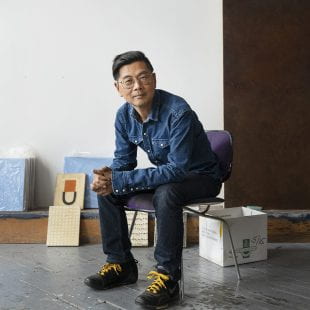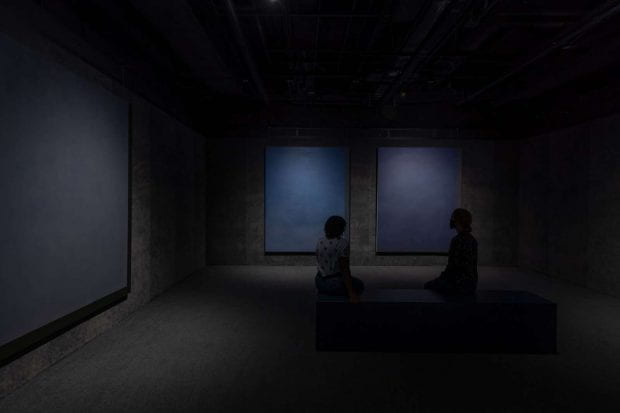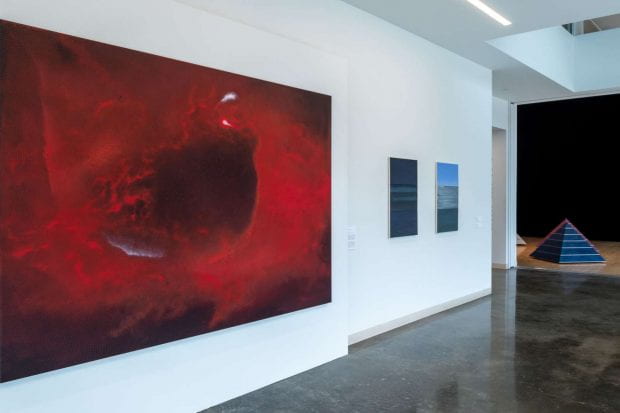The Moody’s artist-in-residence talks university art galleries, color theory and ‘Solaris’
Byron Kim saw a Mark Rothko painting in person for the first time at Yale University Art Gallery. It changed his life.

“Rothko’s work was really formative for me, because in a way it was my entry point for getting really excited about art,” said Byron Kim, this season’s artist-in-residence at Rice’s Moody Center for the Arts.
At the time, Kim was an undergraduate English major at Yale. Today, he’s an internationally renowned painter, a senior critic at the Yale School of Art and this season’s Leslie and Brad Bucher Artist-in-Residence at Rice’s Moody Center for the Arts. Fifteen of Kim’s paintings are currently on display at the Moody, including a series of ocean-inspired triptychs influenced by its spring exhibition, “Artists and the Rothko Chapel: 50 Years of Inspiration.”
Before his chance encounter with a Rothko in the 1980s, Kim said he hadn’t been exposed to much contemporary art, nor was he well-versed in art history. But the young college student found himself confronted with a painting he found profoundly moving in ways he couldn’t yet explain.
“I couldn’t really understand why, or how it was doing that to me,” Kim said.
He graduated from Yale in 1983 with a degree in English — his work remains heavily influenced by literature to this day — and pivoted to art full time. He attended the Skowhegan School of Painting and Sculpture in 1986 before making waves nationally and internationally in 1993 at the Whitney Biennial with his painting “Synecdoche,” an abstract meditation — and ongoing work — on color that evokes skin tones in all their variability.
“Rothko’s work was really formative for me, because in a way it was my entry point for getting really excited about art,” Kim said. “He was my first really strong introduction to abstraction.”
Rothko, an abstract expressionist and a leading figure in color field painting, remains influential for Kim and the other contemporary artists in the Moody’s current show, curated by Frauke Josenhans, associate curator at the Moody, and featuring work by Brice Marden, David Novros, Sam Gilliam, Sheila Hicks and Shirazeh Houshiary.

Byron Kim’s paintings from the “Urban Nights” series (2010-11) hang in the Media Gallery. (Photo by Nash Baker)
In the Moody’s Media Gallery, an intimate space buffeted in gray, sound-dampening fabric, Kim’s paintings of the evening skies above New York and other cities surround the viewer on all sides and create the impression of being suspended in midair. A bench in the middle encourages guests to sit and meditate on the large-scale paintings and their color-saturated canvases in much the same way the octagonal, gray-walled Rothko Chapel does for its display of 14 Rothko panels.
An adjacent gallery holds Kim’s series of ocean images, which were inspired in part by three books with their own relationship to the sea: Homer’s “Odyssey,” Herman Melville’s “Moby Dick” and Stanislav Lem’s “Solaris.” How do you capture something as variable and ever-changing as the ocean? And how do our own perceptions influence the way we see or name its color?
Is it the famous “wine-dark sea” of Homerian description or is it the “deep, blue, bottomless soul” of Ishmael’s retelling? Ancient Greek literature rarely referred to blue, so it’s argued that ancient Greeks perceived the ocean differently than we do. Lem took his sentient ocean, which covers the planet of Solaris, to imaginary realms: it’s “ink-black with bloody flecks,” sometimes “a white sea of fire” and perpetually covered by a pink mist.
Kim’s color work, too, derives from the imagination. You can’t perfectly capture the shifting colors of an ocean or a sky at dusk — and no two people will see those things the same way regardless.
“Different cultures perceive colors differently according to their language — and different people, even within a culture, perceive color differently just because their rods and cones aren’t exactly the same,” Kim said.
“With these recent paintings of the sky and the ocean, I’m not limiting myself to one color as I have done in the past, so a lot of it is imagined.” Books like “Solaris,” he said, “give me license to make any color ocean I like, and I love that.”

Shirazeh Houshiary’s “Flare Up” (2018; foreground) and works by Byron Kim greet visitors to the Moody. (Photo by Nash Baker)
In addition to working with students in a senior studio class in the Department of Visual and Dramatic Arts (VADA), Kim’s other projects as artist-in-residence include an online talk about the ocean with poet Mei-mei Berssenbrugge, which took place in February, and an upcoming screening of the 1972 adaptation of “Solaris” by Russian filmmaker Andrei Tarkovsky, co-organized with Rice Cinema. Kim will host the free online screening March 12 at 7 p.m., and it will include a discussion around such themes as water and color, recurring in both Tarkovsky and Kim’s work.
Kim once flew from New York City to Houston just to sit inside the Rothko Chapel for four hours before hopping a cab back to the airport, a story he relates in the upcoming catalog for the Moody’s spring show. It’s fitting for an artist so inspired by Rothko as a college student to have come full circle, sharing his passion for contemporary art and abstract expressionism with a new generation of undergraduates through both his work at the Moody and his work with this semester’s VADA students.
“It’s important to have students exposed to contemporary art as well as historical art,” Kim said. “That’s the great thing about a place like Rice or like Yale, where there are the resources to expose even a small number of students to something they would not be able to be exposed to otherwise — whatever their field.”
“Solaris” virtual film screening hosted by artist-in-residence Byron Kim, March 12, 7 p.m., free. moody.rice.edu/events/solaris-andrei-tarkovsky-1972-virtual-film-screening.

